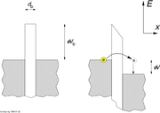
Coulomb blockade
Overview
Charles-Augustin de Coulomb
Charles-Augustin de Coulomb was a French physicist. He is best known for developing Coulomb's law, the definition of the electrostatic force of attraction and repulsion. The [SI unit] of charge, the coulomb, was named after him....
's electrical force, is the increased resistance
Electrical resistance
The electrical resistance of an electrical element is the opposition to the passage of an electric current through that element; the inverse quantity is electrical conductance, the ease at which an electric current passes. Electrical resistance shares some conceptual parallels with the mechanical...
at small bias voltages of an electronic device comprising at least one low-capacitance
Capacitance
In electromagnetism and electronics, capacitance is the ability of a capacitor to store energy in an electric field. Capacitance is also a measure of the amount of electric potential energy stored for a given electric potential. A common form of energy storage device is a parallel-plate capacitor...
tunnel junction
Tunnel junction
A tunnel junction is any junction between two different materials, where electrons move through the junction by quantum tunneling. Tunnel junctions serve a wide variety of different purposes....
. Because of the CB, the resistances of devices are not constant at low bias voltages, but increase to infinity for zero bias (i.e. no current flows).
A tunnel junction is, in its simplest form, a thin insulating barrier between two conducting electrode
Electrode
An electrode is an electrical conductor used to make contact with a nonmetallic part of a circuit...
s.

